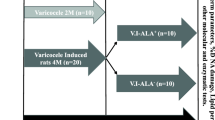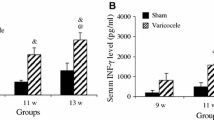Abstract
Nitric oxide (NO) has been reported to be increased in the spermatic veins of men affected by varicocele. The aim of the present study was to determine whether iNOS (inducible nitric oxide synthase) has a role in testicular dysfunction associated with varicocele, immunohistochemistry analyze was used to study iNOS activity in testis of adolescent rats with experimental left varicoceles. Rats were randomly divided into three groups. The first group consisted of rats undergoing partial ligation of left renal vein (n:12). The second group consisted of rats undergoing a sham operation (n:6) and, the third group referred to as control rats (n:7). Immunohistochemistry slides were evaluated by counting the number of positive cells and expressed as percents (% iNOS activity). We found that iNOS was predominantly expressed in the cytoplasm of Leydig cells in each group and only a small amount of iNOS was expressed in Sertoli cells. There were significant differences in % iNOS activity between both testes of varicocele group and both of testes control group(p < 0.01), but no significant differences were noted between other groups (p > 0.05). Because of iNOS activity was markedly increased in the Leydig cells of varicocele bearing rats, we suggest that iNOS activity may play a role in the testicular dysfunction associated with varicocele during adolescence.
Similar content being viewed by others
References
Dubin L, Amelar RD. Etiologic factors in 1294 consecutive cases of male infertility. Fertil Steril 1971; 22: 469–474.
Kay R, Alexander NJ, Baughman WL. Induced varicocele in Rhesus monkeys. Fertil Steril 1979; 31: 195–199.
Al-Juburi A, Pranikoff K, Dougherty KA, Urry RL, Cockett AT. Alteration of semen quality in dogs after creation of varicocele. Urology 1979; 13: 535–539.
Harrison RM, Lewis, RW, Roberts JA. Pathophysiology of varicocele in nonhuman primates: long-term seminal and testicular changes. Fertil Steril 1986; 46: 500–510.
Choi H, Kim KS, Kim km. The effect of experimental varicocele on the testis of adolescent rats. J Urol 1990; 144: 499–501.
Li H, Dubocq F, Jiang Y, Tiguert R, Gheiler EL, Dhabuwala CB. Effect of surgically induced varicocele on testicular blood flow and Sertoli cell function. Urology 1999; 53: 1258–1262.
Takihara H, Sakatoku J, Cockett ATK. The pathophysiology of varicocele in male infertility. Fertil Steril 199; 155: 861–868.
Turner TT. The study of varicocele through the use of animal models. Hum Reprod Update 2001; 7(1): 78–84.
Lowenstein CJ, Dinerman JL, Synder SH. Nitric oxide: a physiologic messenger. Ann Intern Med 1994; 120: 227–237.
Lowenstein CJ, Synder SH. Nitric oxide, a novel biologic messenger. Cell 1992; 70: 705–707.
Moncada S, Palmer RM, Higgs EA. Nitric oxide: physiology, pathophysiology, and pharmacology. Parmacol Rev 1991; 43: 109–142.
Forstermann U, Gath I, Schwarz P, Closs EI, Kleinert H. Isoforms of nitric synthase: properties cellular distribution and expressional control. Biochem Pharmacol 1995; 50: 1321–1332.
Geller DA, Billiar TR. Molecular biology of nitric oxide synthases. Cancer Metastasis Rev 1998; 17: 7–23.
Nathan C. Inducible nitric oxide synthase: what difference does it make? J Clin Invest 1997; 100: 2417–2423.
Roselli M, Keller PJ, Dubey RK. Role of nitric oxide in the biology, physiology, and pathophysiology of reproduction. Hum Reprod Update 1998; 4: 3–24.
Kostic T, Andric S, Kovacevic R, Maric D. The involvement of nitric oxide in stress-impaired testicular steroidogenesis. Eur J Pharmacol 1998; 10:(346) 267–273.
Del Punta K, Charreau EH, Pignataro OP. Nitric oxide inhibits Leydig cell steroidogenesis. Endocrinology 1996; 137: 5337–5343.
Kostic TS, Andric SA, Maric D, Stojilkovic SS, Kovacevic R. Involvement of inducible nitric oxide synthase in stress-impaired testicular steroidogenesis. J Endocrinol 1999; 163: 409–416.
Koziel E, Kotula M, Andronowska A, Pierscinski A, Bilinska B. Correlation between NADPH-diaphorase and iNOS in bank vole Leydig cells in vitro and in testicular sections with the use of histochemistry and immunocytochemistry. Folia Histochem Cytobiol 2000; 38: 71–78.
Fujisawa M, Tatsumi N, Fujioka H et al. Nitric oxide production of rat Leydig and Sertoli cells is stimulated by round spermatid factor(s). Mol Cell Endocrinol 2000; 60: 99–105.
Pomerantz DK, Pitelka V. Nitric oxide is a mediator of the inhibitory effect of activated macrophages on production of androgen by the Leydig cell of the mouse. Endocrinology 1998; 193: 922–931.
Stephan JP, Guillemois C, Jegou B, Bauche F. Nitric oxide production by Sertoli cells in response to cytokines and lipopolysaccharide. Biochem Biophys Res Commun 1995; 213: 218–224.
Tatsumi N, Fujisawa M, Kanzaki M, Okuda Y, Okada H, Arakawa S, et al. Nitric oxide production by cultured rat Leydig cells. Endocrinology 1997; 138: 994–998.
Weiss DB, Rodriguez-Rigau LJ, Smith KD, Steinberger E. Leydig cell function in oligospermic men with varicocele. J Urol 1978; 120: 427–430.
Mitropoulos D, Deliconstantinos G, Zervas A, Villiotou V, Dimopoulos C, Stavrides J. Nitric oxide synthase and xanthine oxidase activities in the spermatic vein of patients with varicocele: a potential role for nitric oxide and peroxynitrite in sperm dysfunction. J Urol 1996; 156: 1952–1958.
Ozbek E, Turkoz Y, Gokdeniz R. Increased nitric oxide production in the spermatic vein of patients with varicocele. Eur Urol 2000; 37: 172–175.
Romeo C, Ientile R, Impellizzeri P, Turiaco N, Teletta M, Antonuccio P, Basile M, Gentile C. Preliminary report on nitric oxide-mediated oxidative damage in adolescent varicocele. Hum Reprod 2003; 18: 26–29.
Baker HJ, Lindsey JR, Weisbroth SH. Selected normative data. In: The laboratory Rat, vol 2. New York: Academic Press, 1980: appendix 1, 257–258.
Chehval MJ, Martin SA, Alexander NJ, Winkelmann T. The effect of unilateral injury to the vas deferens on the contralateral testis in immature and adult rats. J Urol 1995; 153: 1313–1315.
Tomlinson MJ, East SJ, Barratt CL, Bolton AE, Cooke ID. Possible role of reactive nitrogen intermediates in leukocytemediated sperm dysfunction. Am J Reprod Immunol 1992; 27: 89–92.
Weinberg JB, Doty E, Bonaventura J, Haney AF. Nitric oxide inhibition on human sperm motility. Fertil Steril 1995; 64: 408–413.
O'Bryan MK, Schlatt S, Gerdprasert O, Phillips DJ, de Kretser DM, Hedger MP. Inducible nitric oxide synthase in the rat testis. Evidence for potential roles in both normal function and inflammation-mediated infertility. Biol Reprod 2000; 63: 1285–1293.
Santoro G, Romeo C, Impellizzeri P, Ientile R, Cutroneo G, Trimarchi F et al. Nitric oxide synthase patterns in normal and varicocele testis in adolescents. BJU Int 2001; 88(9): 967–973.
Author information
Authors and Affiliations
Corresponding author
Rights and permissions
About this article
Cite this article
Köksal, İ.T., Erdoğru, T., Gülkesen, H. et al. The potential role of inducible nitric oxide synthase (iNOS) activity in the testicular dysfunction associated with varicocele: An experimental study. Int Urol Nephrol 36, 67–72 (2003). https://doi.org/10.1023/B:UROL.0000032687.58462.4f
Issue Date:
DOI: https://doi.org/10.1023/B:UROL.0000032687.58462.4f




